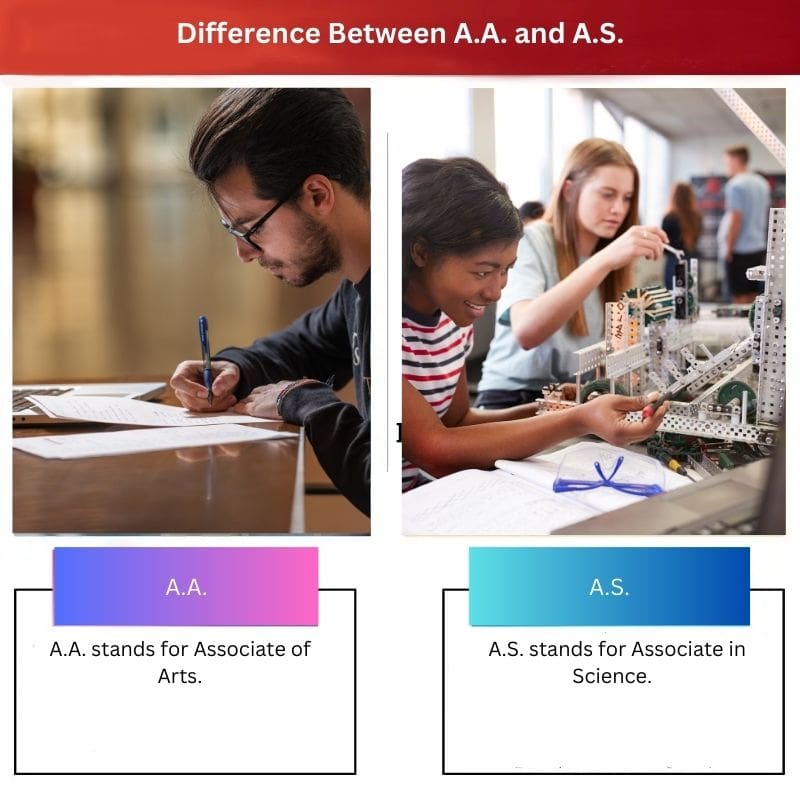A.A. and A.S. are two different degrees that one can earn in college. When it comes to academic programs, there are many differences that set these two apart from each other.
One of the most significant differences is in their length of study time: an undergraduate degree takes four years to complete, while a graduate degree takes five or six years to complete.
The cost of education also varies because some schools charge per credit hour while others charge per semester hours or year hours completed.
Key Takeaways
- A is used before words start with a consonant sound, while an is used before words start with a vowel sound.
- A is the indefinite article, while an is also the indefinite article.
- A and an are used to introduce a singular noun that is not specific.
A.A. vs A.S.
The difference between A. A. and A.S. is that A.A. is a two-year degree, and an A.S. is three years, but it could be more depending on the program of study. Scholarships for this field are very competitive due to the low enrollment rate as well as high tuition rates that come with these degrees, along with their limited availability in many schools around the country. This makes this field both financially and academically challenging.

A.A. is more of an associate degree which is a two-year program that covers general education requirements and some courses in the major area. A.S. is more like a bachelor’s degree or four-year study, though it could be five years, depending on the major areas studied at school.
A.S. is a more advanced degree that is completely focused on the major area. This means you will be taking all courses in your major and may double-major or minor to round out your education.
A.S. degrees are not necessarily easier than A.A., but they come with lower tuition rates for students who plan to transfer their credits from the A.S. to a four-year college or university for their bachelor’s degree.
Comparison Table
| Parameters of Comparison | A.A. | A.S. |
|---|---|---|
| Full form | A.A. stands for Associate of Arts. | A.S. stands for Associate in Science. |
| Length | A.A. is a two-year program. | A.S. is more intensive and can be finished after four years. |
| Degree Types | The Associate of Arts degree can only lead to a Bachelor’s degree. | Associate of Science may also lead to various other degrees such as certificates or a Bachelor’s degree in a different field. |
| Fields | The Associate of Arts is geared more towards humanities | A.S seeks to be more vocational and practical. |
| Classification | A.A may be classified as a liberal arts degree. | But an Associate of Science is more focused on the sciences and mathematics. |
What is A.A.?
A.A. stands for an associate of arts degree and is a two-year study program that offers students some general education as well as courses in their major area or an interest they have developed during high school.
A student may choose to focus on many different areas with the Associate’s Degree but will also need to take general education classes alongside their major.
A.A. degrees are lower because they do not require as many hours of study time, and the classes offered that may transfer to a four-year college or university for their bachelor’s degree are limited.
An A.A. degree may be more affordable, depending on the school and whether or not any of their classes can transfer to a four-year university for their Bachelor’s Degree.
The associate’s degree is shorter, taking two years to complete; this could allow someone who wants to go to a four-year school but doesn’t have the ability to wait for another two years to get their Associate’ Degree and then transfer.
The associate’s degree is not as respected or recognized by some employers because it does not take a four-year commitment like many bachelor’s degrees do and, therefore, may be looked at more negatively.

What is A.S.?
A.S. stands for Associate in Science. Many people mistakenly believe that an A.S.(Associate in Science) degree is the same as a Bachelor’s Degree because it has “associates” and “science.”
High schools offer these two types of degrees, so students might be confused about what they should choose for their first college experience. However, there are important differences between these two degrees.
A Bachelor’s Degree is an undergraduate degree, which requires four years of schooling after high school. A Bachelor’s Degree in Science will require a student to take a series of science courses with lab components that are not included in associate-level coursework and can be more expensive than the Associate levels classes.
An Associate’s Degree is a degree that requires two years of schooling after high school. It can be either an Associate in Science or Associate in Arts, depending on the student’s major and minor choices.
An Associate’s Degree includes classes such as General Chemistry I & II with lab components allowing students to continue their education at a four-year college.
In terms of job outlook, an Associate’s Degree is more versatile than a Bachelor’s degree in that it allows graduates to apply for jobs outside of the scientific field or at lower levels, such as assistant positions in laboratories and pharmaceutical industries.

Main Differences Between A.A. and A.S.
- Associate in Arts (A.A.) and Associate in Science (A.S) the former offer a wide array of humanities courses, while the latter has a concentration on science, engineering, or mathematics.
- Associate in Arts (A.A) provides a wide range of liberal arts courses to equip students with skills needed for many careers, while Associate in Science (A.S.) is the natural sciences and mathematics-oriented degree that prepares them for graduate school.
- Associate in Arts (A.A) is not a prerequisite for graduate study, but it does provide an important background to develop skills for many careers and leads to transfer credits at four-year colleges or universities. The Associate in Science (A.S.) program offers students the opportunity of pursuing a rigorous curriculum with great flexibility within the general science disciplines.
- Associate in Arts (A.A) is not the same as an Associate of Science degree, which has a more natural sciences focus that would prepare them for graduate school; however, both are fully accredited degrees from JWU and will get you where you want to go. A.S. degree will prepare students for a career in many areas of science, including biochemistry, microbiology, forensic sciences, and more.
- The Associate in Arts (A.A) program offers students the opportunity of pursuing a broad range of liberal arts courses rather than focusing on one subject as much of the Associate of Science (A.S) program does.

- https://search.proquest.com/openview/00b79390bdcd6bb4cb380b182bb96316/1?pq-origsite=gscholar&cbl=18750
- https://www.tandfonline.com/doi/abs/10.1080/10668926.2018.1478346

This detailed comparison effectively highlights the differences between A.A. and A.S. degrees, providing clarity on the length, fields, and classification of each degree. It’s a valuable resource for individuals considering their educational paths.
Absolutely, the article delivers a comprehensive analysis of A.A. and A.S. degrees, enabling readers to gain deeper insights into the distinctions and implications associated with each degree type.
The comparison table is particularly informative, offering a concise breakdown of the differences between A.A. and A.S. degrees. This structured approach enhances the clarity of the contrasts.
I couldn’t agree more. The table provides a quick reference point for those seeking to differentiate between the two degrees, allowing for better understanding and decision-making.
Spot on. The table is a valuable summary of the key differences, making it easier for students to grasp the distinctions without delving into lengthy paragraphs of text.
The delineation of A.A. and A.S. degrees is clearly articulated, providing readers with a thorough understanding of the differences and implications associated with each option.
The article delivers a detailed examination of A.A. and A.S. degrees, providing readers with a comprehensive understanding of the differences in length, focus, and potential pathways after completion.
The distinction between A.A. and A.S. degrees is clearly articulated in this article, providing a comprehensive overview of the differences in length, focus, and potential pathways after completion.
Absolutely. The article effectively addresses the misconceptions and nuances associated with both A.A. and A.S. degrees. It’s a valuable resource for students and parents alike.
The comparison between A.A. and A.S. degrees is thorough and insightful, enabling readers to discern the differences in degree types, areas of focus, and potential classifications. It serves as a valuable reference for students and parents alike.
Absolutely, the article provides a holistic view of A.A. and A.S. degrees, offering a detailed comparison of their fields and classifications that would greatly aid students in making well-informed decisions.
I concur. The comprehensive comparison table further enriches the understanding of A.A. and A.S. degrees, emphasizing the significance of their respective fields and degree types.
The article effectively captures the key takeaways and highlights the various aspects of A.A. and A.S. degrees. It’s beneficial for prospective students to understand the differences and make informed decisions.
Indeed, the cost, length, and area of focus for both degrees are clearly explained. This holistic comparison is valuable for students who are weighing their college education options.
This article offers a comprehensive comparison between A.A. and A.S. degrees, addressing their distinctive features and educational pathways. It’s beneficial for individuals seeking clarity on their college choices.
Agreed. The article effectively delves into the nuances of A.A. and A.S. degrees, enabling readers to weigh their options and identify the most suitable path for their academic pursuits.
The detailed explanation of A.A. and A.S. degrees, along with their individual characteristics, provides a comprehensive overview for readers. It’s a great guide for those navigating higher education choices.
Absolutely, the article offers a balanced comparison of A.A. and A.S., considering various factors such as length, types, and fields. It equips readers with valuable insights to make informed decisions.
This article provides an insightful comparison between A.A. and A.S. degrees, emphasizing their differences in length and cost of education. The table provided further clarifies their distinct features, making it easier to differentiate between the two.
I agree. The information presented is very clear and helpful for those considering the pursuit of either degree. The breakdown of A.A. and A.S. characteristics is particularly useful.